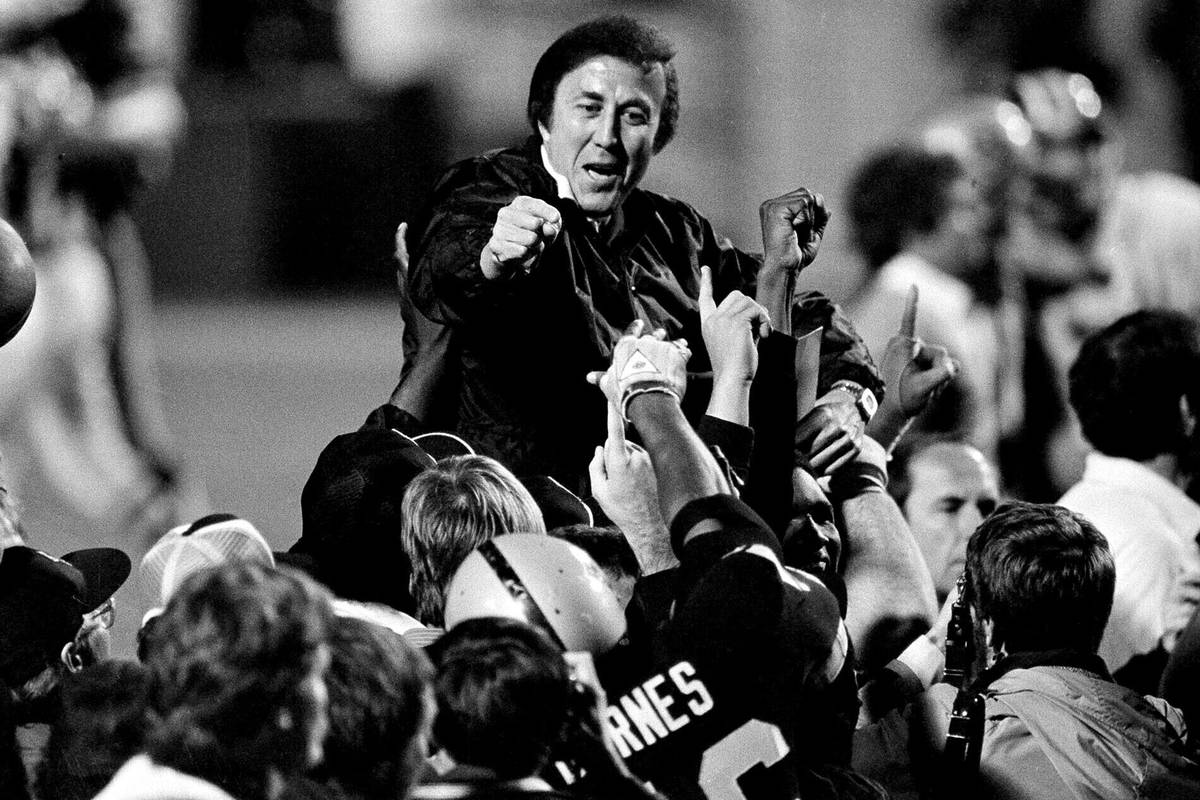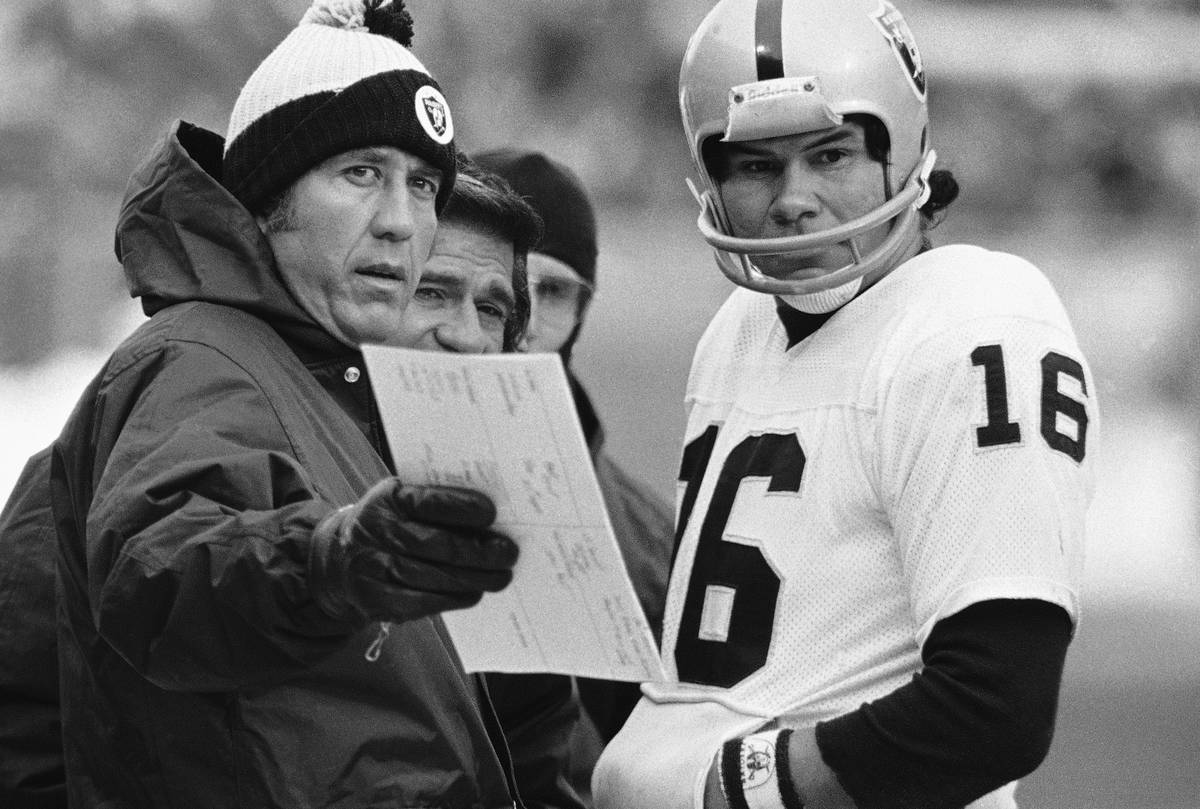Raiders’ legend Tom Flores hopes to cap career in Canton
Former Raiders coach Tom Flores didn’t need to yell, scream or curse to communicate a message to his players. That wasn’t his modus operandi, his style.
He preferred to err on the side of subtlety.
“He would take the practice guide, roll it up in his hand. It’d be in his right hand. He’d hit his left hand with it, and everybody would know he was mad,” said former Raiders running back turned Las Vegas resident Frank Hawkins, who played seven years for Flores.
“He’s cool, calm and collected.”
Flores retired from coaching in 1994 and has coolly, calmly waited for Saturday, when he could finally cap his legendary career with enshrinement in the Pro Football Hall of Fame. The museum is unveiling its 2021 class Saturday night during the broadcast of the NFL Honors.
The 83-year-old, who was the first Hispanic quarterback, head coach and general manager in pro football, was announced as a finalist in August by the Hall’s selection committee.
He certainly qualifies for serious consideration for Canton, Ohio, where the museum is housed — having coached the Raiders to two Super Bowls after quarterbacking the team for seven seasons, including the inaugural 1960 campaign.
“You’ll never hear Coach Flores say a disparaging word, even though we all knew he should be in there,” Hawkins said. “That just shows you the kind of character he’s got.”
More than hobby
Football was but a hobby for Flores, who fancied basketball while growing up near Fresno, California. He played football for fun with friends until he began attending Sanger Union High School, where the football stadium now bears his name. It was there that the sport became a passion and priority as the team’s starting quarterback.
He would tune out his teachers during his monotonous classes and doodle eccentric plays instead. He’d even run some of them in games, giving him an early foray into coaching.
But he didn’t think much about a future in football until his senior year.
“I didn’t even know what a scholarship was,” Flores said last month during a phone interview from his home in Indian Wells, California. “The thoughts were ‘Have fun, play with your buddies,’ and then graduate from high school and get a job. That was the objective of a lot of guys. Not too many guys were thinking of college.”
But Fresno City College had other ideas for Flores, as did the University of Pacific and the Calgary Stampeders of the CFL, two other stops in his playing career.
But an injured throwing shoulder stymied Flores’ newly found professional aspirations, and he returned to college to finish his degree, content with finishing his football career and working as a teacher. He had surgery to repair the injury and tried out for the NFL’s Washington Redskins shortly thereafter, “failing miserably,” after which he prepared to move on for good.
“I was getting just about ready to sign the dotted line” for a job at a local high school,” Flores said. “All of a sudden, I get a call from this American Football League, and I say ‘What the hell is that?’”
Turns out the AFL was an upstart football league that sought to compete with the NFL. One of the franchises, the Raiders, needed a quarterback, and called upon Flores to fill the void. He rehabilitated his shoulder and quarterbacked the team until 1966, accumulating 11,635 passing yards, 92 touchdowns and a Pro Bowl nod during his seven-year tenure.
He was also a backup for the Buffalo Bills and Kansas City Chiefs, winning a Super Bowl with Kansas City in 1969.
“It was just something I loved,” Flores said of his playing career. “But all of a sudden, there was nowhere to go. No one wanted me as a quarterback anymore. It was getting harder and harder to find a job some place. … (Coaching) was a way to stay in the game. Then I found out I was pretty good.”
‘The golden rule’
Flores was hired in 1971 by the Buffalo Bills, with whom he coached wide receivers for one season. He returned home to the Bay Area during the offseason and learned of an opening with the Raiders, prompting a call to former owner Al Davis.
He spent the ensuing seven seasons as an assistant on John Madden’s staff, developing the voice he’d eventually use as the team’s head coach.
“I always paid attention when other coaches were making points on the field,” Flores said. “I learned. I learned both sides of the ball. That’s part of why I got to where I am now.”
Flores replaced Madden in 1979 and drew on his playing experience as he created his coaching culture. He prioritized the golden rule: “I used to tell my coaches, ‘Don’t ever forget what it was like to play. Don’t think that you know it all and don’t treat somebody like you wouldn’t want to be treated.”
He was thoughtful and progressive in leading the Raiders to a 91-56 mark in nine seasons, including five playoff berths and victories in Super Bowl XV and Super Bowl XVIII. He fostered harmony in a locker room that featured several eccentric players and personalities.
“He treated you as a grown man,” said former Raiders All-Pro safety Vann McElroy. “He was very, very clear. He wanted you to treat (football) as a job, take it very seriously. When you do that, he will treat you with respect and just be a guy who’s always there for you.”
Flores made an indelible mark on the franchise and stepped down following the 1987 season. He was hired by the Seattle Seahawks as general manager in 1989 and coached the team from 1992 until his dismissal in 1994.
He returned to the Raiders in 1997 as the team’s color commentator on radio broadcasts, working in that role until 2018. He fondly recalls the trials and tribulations he endured, while begrudgingly admitting that he believes he should have been inducted into the Pro Football Hall of Fame already.
For the record, McElroy and Hawkins agree.
“I love him. I love what he’s done for football,” Hawkins said. “The National Football League is better because of Coach Flores, and he should be in the Hall of Fame.”
Added Flores: “If it happens and when it happens, I will be more than elated. It would be special … There’s a certain mystique to the journey, but you don’t write the ending. You live the ending.”
Contact reporter Sam Gordon at sgordon@reviewjournal.com. Follow @BySamGordon on Twitter.
Flores coaching record
Raiders
1979: 9-7
1980: 11-5, 4-0 playoffs, Super Bowl XV champions
1981: 7-9
1982: 8-1, 1-1 playoffs
1983: 12-4, 3-0 playoffs, Super Bowl XVIII champions
1984: 11-5, 0-1 playoffs
1985: 12-4, 0-1 playoffs
1986: 8-8
1987: 5-10
Seattle Seahawks
1992: 2-14
1993: 6-10
1994: 6-10
Overall: 97-87, 8-3 playoffs
























